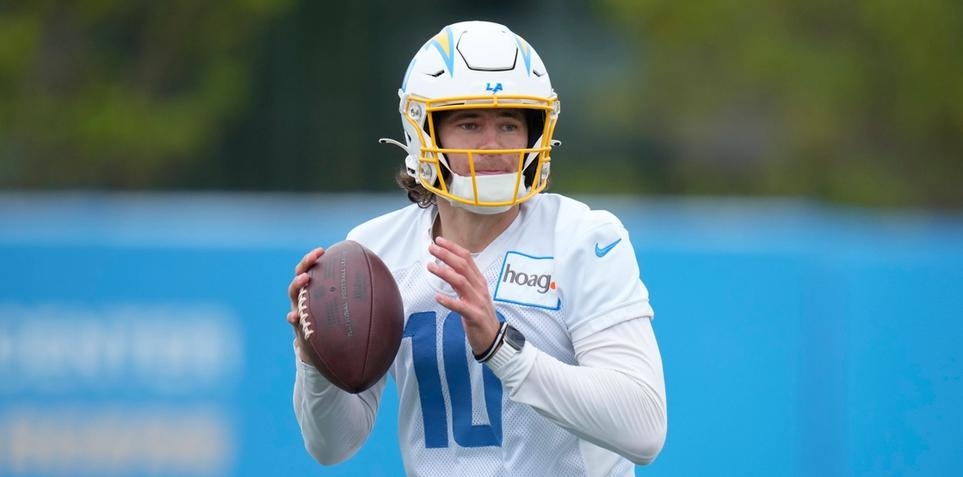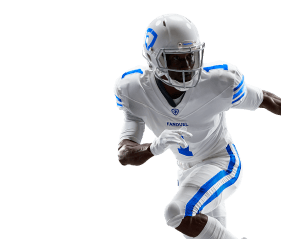QB Regression: Justin Herbert, Russell Wilson Should Score More in 2023

When it comes to fantasy football -- and daily fantasy football or best-ball fantasy football -- touchdowns matter.
A lot.
Outlier games (which are crucial for every type of fantasy football) are tied quite heavily to touchdown variance, and that means we need to target touchdown scorers.
But we also don't want to chase touchdown scorers -- because that can be a bad long-term strategy.
Though that sounds like a bold claim, touchdown regression is a very real thing, and history indicates that we should take advantage.
In order to do that, I'll be looking at quarterbacks who overperformed (and underperformed) in the touchdown department in 2022 -- and lay out why it makes sense to put stock into what we see.
Defining Touchdown Regression
The idea of regression can be both complex and oversimplified, and I'm initially going to err on the side of oversimplifying it.
Simply put, regression suggests that players will return to a baseline level of performance over a larger sample.
When a player scores a ton of touchdowns, he's probably good, yes, but he's also likely to score fewer touchdowns moving forward and trend back toward his long-term baseline.
Likewise, when a player -- say -- racks up elite yardage but scores just a handful of times, he's likely to score at a higher rate moving forward.
To make it a little more complex now -- and don't worry if math isn't your thing; we're just talking touchdowns here -- we can leverage a regression model to compare various stats to touchdown totals, determine a mathematical relationship between the two stats, and then use that to find expected touchdown output.
To varying degrees, passing stats such as passing yards, passing air yards, and numberFire's Passing Net Expected Points (NEP) tell us a lot about touchdown totals (NEP is just an Expected Points Added [EPA] model by another name).
History tells us that when yardage goes up, touchdown totals go up. And we can put a tangible number on exactly how much yardage and NEP tell us about touchdowns -- that's our key here.
Testing the Process
I'm going to go over how predictive this process is, but if you're not interested in that, you can just skip down to the results and dig into this upcoming season's regression candidates.
We'll look at touchdown totals, but the primary focus is on touchdown rates (passing touchdowns per pass attempt) to identify positive and negative regression. This will adjust for players with different passing volume from one year to the next.
For passing touchdowns, I'm defining expected passing touchdowns (xTD) as the average expected number from two different methods that had the strongest predictive power through testing.
- Passing Yards
- Successful Drop Backs
Successful drop backs are defined as drop backs that increased a team's NEP or EPA. That means successful drop backs are a combination of volume and efficiency.
From 2012 through 2021, there have been 81 qualified quarterbacks (minimum 100 pass attempts) with a touchdown rate at least 1.0 percentage points higher than their expected touchdown rate (xTD%).
So, to clarify, these players scored at a noticeably higher rate than the underlying data claims they should have.
Of these 81, 61 had at least 100 pass attempts again in the following season, thus allowing us to compare year-over-year performance in touchdown rate for individual players.
Of these 61 qualified overachievers, 51 of them saw a decrease in their passing touchdown rate the following season. That's 83.6%.
Of the 10 with an actual increase, 3 of them had a touchdown rate increase of 1.0% or less. That gives us just 7 of 61 (11.5%) able to put together consecutive outlier seasons. -- not great odds, there.
On the other side of things, we have 49 qualified underachievers.
Of those 49, 46 (93.9%) increased their touchdown rate the next season, doing so by an average of 1.6%.
Of the three who had back-to-back bad-luck seasons, none saw their touchdown rate fall by more than 0.5%.
If the goal is to find players whose touchdown rates should fluctuate (and it is) next season, this is a pretty strong process.
Quarterback Regression Candidates for 2023
Here's a snapshot of the 2022 quarterback class, their touchdown numbers, their expected touchdown numbers (passing and rushing), and the difference between those two.
Note: The league-wide passing touchdown rate was down to 4.2%, a five-year low, so we should likely see a league-wide uptick. But that also means we have more underperformers last year than usual.
The table includes rushing touchdowns and is sorted by total expected touchdowns from 2022's performance.
Right off the bat, we see a lot of big names at the top of the list when sorting by expected total touchdowns: Patrick Mahomes, Josh Allen, Justin Herbert, and Joe Burrow.
That's nice to see, of course. But here are some noteworthy quarterbacks in terms of regression.
Justin Herbert, Los Angeles Chargers
Herbert fell more than 10(!) scores shy of his expected touchdown output in 2022. His 25-touchdown season came on the strength of 4,739 passing yards: second-most in the NFL. For context, Burrow threw for 264 fewer yards (4,475) but 10 more touchdowns (35).
The math says that Herbert should have had 32.8 passing touchdowns and 2.2 rushing touchdowns (he didn't have a rushing score in 2022).
There may be no more obvious regression candidate entering 2023 than Herbert, who is currently the QB6 in FanDuel's best ball fantasy football format.
Jalen Hurts, Philadelphia Eagles
Jalen Hurts (QB2 on FanDuel) more or less broke the league last season with his quarterback sneaks. Historically speaking, Hurts should have had 8.6 rushing touchdowns rather than 18, which is a massive shift, but long-term regression can't exactly account for the most unstoppable play in football history: a Jalen Hurts sneak.
Along with that, Hurts actually underperformed as a passer in the touchdown column (by 0.8 scores)
Although his touchdown totals could fluctuate this year, there are more reasons to be bullish on him than bearish.
Daniel Jones, New York Giants
Another NFC East passer should see some touchdown rate swings: Daniel Jones.
Jones, the QB16 by average draft position, threw for just 15 scores in 2022 on 241 successful drop backs.
Derek Carr had 240 successful drop backs -- and 24 passing scores. Hurts' 22 passing touchdowns stemmed from 233 passing successes.
Russell Wilson, Denver Broncos
The 2022 season was pretty rough for Russell Wilson and the Denver Broncos.
Wilson totaled just 19 touchdowns (16 passing and 3 rushing) while throwing for 3,524 yards.
That's a big reason why he's being drafted, on average, as the QB18.
He should've been closer to 20.9 passing touchdowns, though. In fact, if we were to use the air yards method (which is a little less predictive than some other measures I'm using and isn't actually factored into the xTD numbers), then Wilson would have an xTD total of 25.0.
With a new coaching staff in place, the Broncos are set up for a big shift in offensive success.
Kenny Pickett, Pittsburgh Steelers
Kenny Pickett's rookie season got off to a slow start, and he didn't see the field until Week 4. He also failed to play full games in Weeks 6 and 14.
But the Pittsburgh Steelers' franchise quarterback should have a better sophomore season in the scoring column.
Pickett wound up with more interceptions (9) than touchdowns (7), and while the expected touchdown totals weren't earth-shattering (15.7), that's more than double his actual total through the air.
Pickett also showed some skill on the ground: 244 yards on 50 carries for some of the best EPA-centric metrics at the position. His three scores were totally valid, so the arrow is up on Pickett, the QB23 by best ball average draft position.
The above author is a FanDuel employee and is not eligible to compete in public daily fantasy contests or place sports betting wagers on FanDuel. The advice provided by the author does not necessarily represent the views of FanDuel. Taking the author's advice will not guarantee a successful outcome. You should use your own judgment when participating in daily fantasy contests or placing sports wagers.



